Conosciamo la sensazione. Quel momento di sconforto in cui il vostro sito va giù e non avete idea del perché. È uno degli errori più comuni di WordPress, ma anche uno dei più misteriosi. Non vi dice cosa c’è che non va, ma solo che qualcosa è rotto.
La buona notizia? È quasi sempre risolvibile. Avendo aiutato innumerevoli personalizzati, abbiamo avuto a che fare con questo errore molto spesso.
In questa guida vi illustreremo i passaggi esatti per ripristinare il vostro sito e renderlo funzionante. Seguiteci e vedrete che tutto tornerà a funzionare in pochissimo tempo.
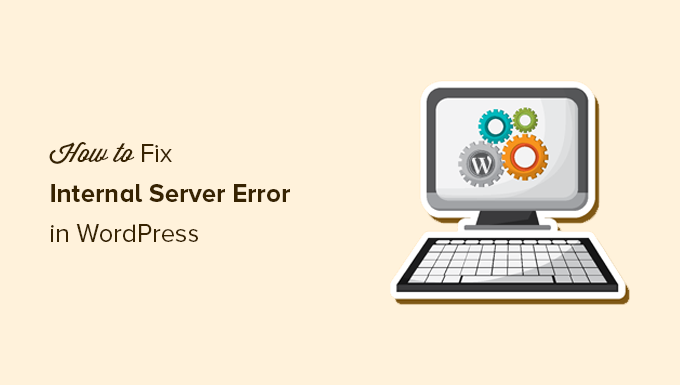
Ecco una rapida panoramica degli argomenti che tratteremo in questo articolo:
- What Is the 500 Internal Server Error?
- What Causes the Internal Server Error in WordPress?
- Fixing the 500 Internal Server Error in WordPress
- Clear WordPress and Browser Cache
- Checking for Corrupt .htaccess File
- Increasing the PHP Memory Limit
- Deactivate All WordPress Plugins
- Switch to a Default WordPress Theme
- Re-Uploading Core Files
- Enable Debug Logs in WordPress
- Ask Your Hosting Provider
- Video Tutorial
Che cos’è l’errore 500 Internal Server?
L’errore 500 Internal Server è come una porta bloccata senza chiave. Si sa che qualcosa non va, ma non c’è una nota che spieghi cosa è successo.
Questo errore non riguarda solo WordPress. Può apparire su qualsiasi sito web quando il server incontra un problema che non sa come gestire.
Il “500” nel messaggio è un codice di stato HTTP. Se lo cercate, troverete una definizione vaga:
“Il codice di risposta 500 Internal Server Error indica che il server ha incontrato una condizione inaspettata che gli ha impedito di soddisfare la richiesta”.
Non è molto utile, vero? È il modo in cui il server dice: “Si è rotto qualcosa, ma non sono sicuro di cosa”.
L’aspetto di questo errore dipende dalla configurazione dell’host e dal browser. Ecco un esempio di come appare su un server Apache:
Se il sito viene eseguito su Nginx, l’aspetto potrebbe essere leggermente diverso. Se Google Chrome non riesce a caricare una pagina di errore corretta, si vedrà qualcosa di simile:
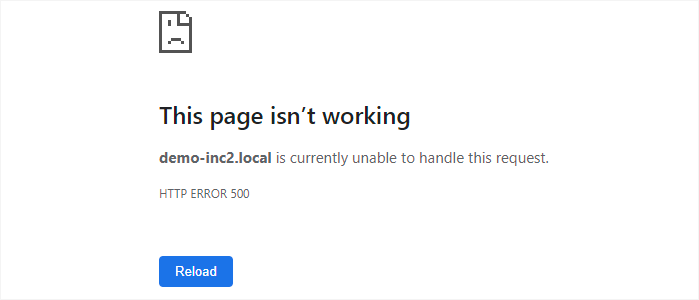
Per i principianti, questa situazione può risultare sconvolgente. Non c’è alcun messaggio che indichi cosa è andato storto o come correggerlo.
È come chiedere a un meccanico di correggere la vostra auto senza dirgli cosa è rotto. Dovranno controllare diverse parti fino a trovare il problema.
In base alla nostra esperienza, il modo migliore per correggere il problema è procedere passo dopo passo. Vi illustreremo le cause e le soluzioni più comuni per far sì che il vostro sito torni a funzionare.
Ottenete l’aiuto di un esperto in qualsiasi momento con il supporto WordPress on-demand!
Affrontare un errore interno del server può essere frustrante. Il nostro Supporto WordPress On-Demand è qui per aiutarvi a correggere i problemi tecnici in modo rapido ed efficace.
- Pagamento unico per l’assistenza on-demand di un esperto
- Tempi di consegna rapidi
- Disponibile 24 ore su 24, 7 giorni su 7
👉 O ttenete subito un supporto di emergenza per WordPress! 🛠️
Cosa causa l’errore interno del server in WordPress?
L’errore interno del server in WordPress è come un puzzle con pezzi mancanti. Sapete che qualcosa non va, ma il messaggio di errore non vi dice esattamente dove si trova il problema.
In base alla nostra esperienza, il colpevole più comune è un file .htaccess corrotto. A volte, si tratta di un plugin che si comporta male o di un tema che non funziona bene con la vostra configurazione.
Altre volte, il sito può colpire il limite di memoria PHP, causando il blocco di WordPress. Anche i file del core corrotti possono innescare questo errore, lasciandovi bloccati senza attenzione.
In alcuni casi, l’errore appare solo quando si cerca di accedere all’area di amministrazione di WordPress, mentre il resto del sito funziona correttamente. È come essere bloccati in casa propria mentre gli ospiti possono ancora entrare dalla porta sul retro.
Ciò che rende questo errore complicato è che di solito si verifica prima che WordPress possa essere caricato correttamente. Ciò significa che il server non può raccogliere abbastanza dettagli per spiegare cosa è andato storto.
Se volete dare un’occhiata più approfondita al funzionamento di WordPress dietro le quinte, consultate la nostra guida su come WordPress opera sotto il cofano.
Passiamo ora alla risoluzione dei problemi per ripristinare il funzionamento del sito.
Risolvere l’errore 500 Internal Server in WordPress
Prima di iniziare la risoluzione dei problemi, assicuratevi di avere a portata di mano un backup completo di WordPress del vostro sito web.
Se avete accesso all’area di amministrazione di WordPress, potete utilizzare un plugin di backup per WordPress per creare un backup completo del vostro sito web.
Per questo consigliamo di utilizzare Duplicator. Non solo vi aiuta a eseguire rapidamente il backup del vostro sito web, ma potete anche archiviare i vostri backup sul cloud e, soprattutto, potete ripristinare il vostro sito web dal backup.
D’altra parte, se non avete accesso all’area di amministrazione di WordPress, potete creare manualmente un backup di WordPress utilizzando phpMyAdmin e un client FTP.
In seguito, potete seguire i seguenti passaggi per risolvere il problema e risolvere l’errore del server interno sul vostro sito web.
Cancellare la cache di WordPress e del browser
I browser e i plugin di caching di WordPress possono talvolta memorizzare erroneamente una copia in cache di una pagina di errore.
Il modo più semplice per risolvere il problema è cancellare la cache del browser.
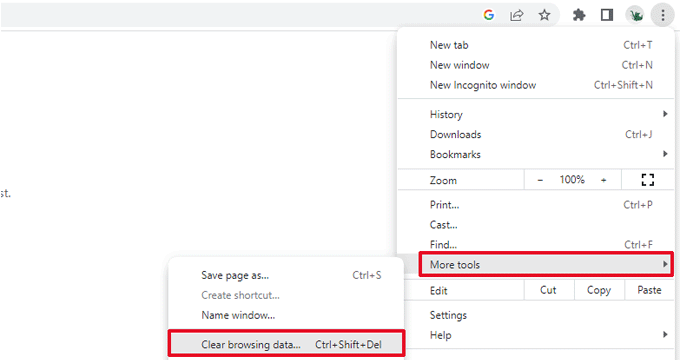
Dopodiché, se avete accesso all’area di amministrazione di WordPress del vostro sito web, potete svuotare la cache di WordPress visitando la pagina delle impostazioni del vostro plugin di caching.
Per maggiori dettagli, consultate il nostro tutorial su come cancellare la cache di WordPress.
Verifica della presenza di un file .htaccess corrotto
Il file .htaccess è un file di configurazione del server utilizzato da WordPress per impostare i reindirizzamenti.
Una delle cause più comuni di errore interno del server è il file .htaccess corrotto.
Il modo più semplice per correggere questo problema è semplicemente visitare la pagina Impostazioni ” Permalinks nell’area di amministrazione di WordPress e poi fare clic sul pulsante “Salva modifiche” senza apportare alcun cambiamento.
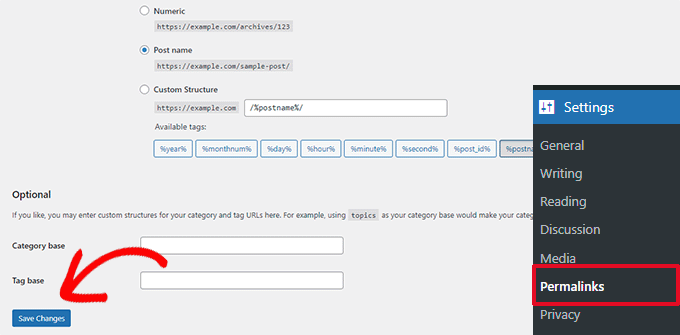
WordPress cercherà ora di aggiornare il file .htaccess o di generarne uno nuovo. Ora è possibile visitare il sito web per verificare se l’errore del server interno è stato corretto.
Se l’errore è ancora visibile, è necessario assicurarsi che WordPress sia stato in grado di generare o scrivere sul file .htaccess.
A volte, a causa delle autorizzazioni di file e directory, WordPress potrebbe non essere in grado di creare o scrivere sul file .htaccess.
Ora potete provare a sostituire il file .htaccess manualmente. Per prima cosa, dovete accedere al vostro sito web utilizzando l’FTP o l’applicazione File Manager nel pannello di controllo del vostro account di hosting.
Successivamente, è necessario rinominare ilfile .htaccess principale in qualcosa come .htaccess_old. Questo vi consente di mantenere il file come backup, ma WordPress non lo riconoscerà.
Per rinominare il file .htaccess, dovrete accedere al vostro sito utilizzando l’FTP o l’applicazione File Manager nel cruscotto del vostro account di hosting.
Una volta collegati, il file .htaccess si troverà nella stessa directory in cui sono presenti cartelle come wp-content, wp-admin e wp-includes.
È sufficiente fare clic con il tasto destro del mouse sul file .htaccess e rinominarlo in .htaccess_old.
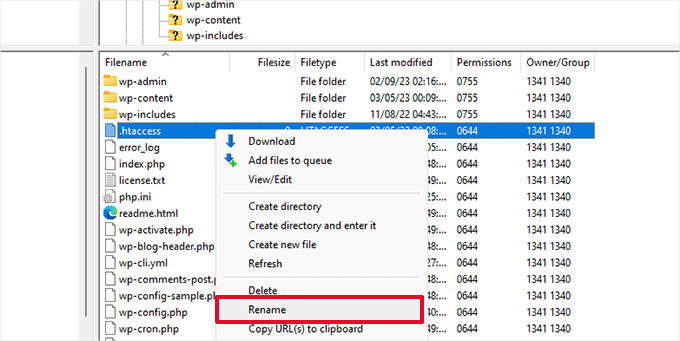
Successivamente, è necessario creare un nuovo file .htaccess.
All’interno della cartella principale del sito, fare clic con il tasto destro del mouse e selezionare l’opzione “Crea nuovo file” nel client FTP o nell’applicazione File Manager.
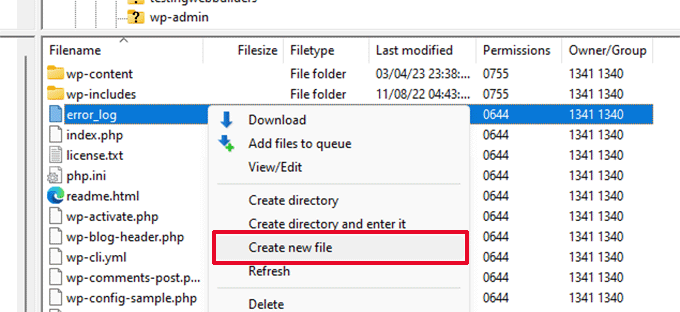
Nominate questo nuovo file .htaccess e fate clic su “OK” per salvarlo.
Ora, questo file .htaccess è attualmente vuoto ed è necessario aggiungervi le regole di riscrittura predefinite di WordPress.
È sufficiente fare clic con il tasto destro del mouse sul file e selezionare “Visualizza/Modifica” nel client FTP o nell’applicazione File Manager.
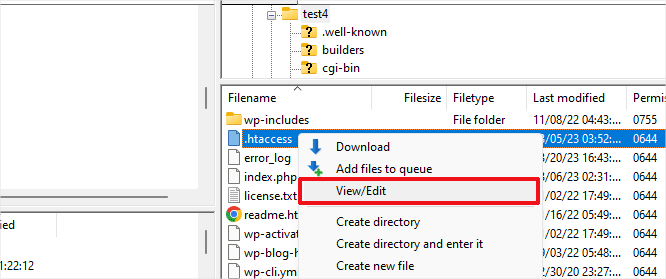
Il file vuoto si aprirà in un editor di testo semplice come Notepad o TextEdit.
A questo punto, è necessario copiare e incollare il seguente codice al suo interno:
1 2 3 4 5 6 7 8 9 10 | # BEGIN WordPress<IfModule mod_rewrite.c>RewriteEngine OnRewriteBase /RewriteRule ^index.php$ - [L]RewriteCond %{REQUEST_FILENAME} !-fRewriteCond %{REQUEST_FILENAME} !-dRewriteRule . /index.php [L]</IfModule># END WordPress |
Questo codice è il set di regole predefinito utilizzato da WordPress. Non dimenticate di salvare le modifiche e di caricare il file sul server.
Ora è possibile visitare il sito web per verificare se l’errore del server interno è stato risolto.
In caso affermativo, allora datevi una pacca sulla spalla perché avete risolto l’errore interno del server.
Importante: prima di procedere con altre operazioni, assicuratevi di andare alla pagina Impostazioni ” Permalinks nell ‘area di amministrazione di WordPress e di fare clic sul pulsante Salva senza apportare alcuna modifica. In questo modo il file .htaccess verrà rigenerato con regole di riscrittura adeguate per garantire che le pagine dei vostri post non restituiscano un errore 404.
Se la soluzione per verificare la presenza di un file .htaccess corrotto non ha funzionato, allora dovete continuare a leggere questo articolo.
Aumentare il limite di memoria di PHP
A volte, l’errore interno del server può verificarsi se uno script consuma tutto il limite di memoria di PHP.
Il modo più semplice per aumentare il limite di memoria di PHP è modificare il file wp-config.php. Se siete principianti, fate attenzione a questa operazione. Seguite attentamente queste istruzioni, perché anche piccoli errori nei file principali di WordPress possono danneggiare il vostro sito.
Per iniziare, è sufficiente collegarsi al proprio sito web WordPress utilizzando un client FTP o l’applicazione File Manager nel pannello di controllo del proprio account di hosting.
Il file wp-config.php si trova nella cartella principale del vostro sito web. Fate clic con il tasto destro del mouse su di esso e selezionate “Scarica”. In questo modo vi assicurerete di avere un file di backup nel caso in cui qualcosa vada storto.
Una volta salvato, è possibile fare clic con il pulsante destro del mouse e selezionare “Visualizza/Modifica”.
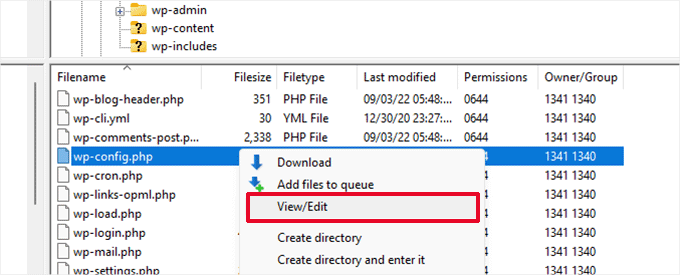
All’interno del file wp-config.php, è necessario aggiungere il seguente codice appena sopra la riga che recita: “Questo è tutto, smettete di modificare! Buona pubblicazione”:
1 | define( 'WP_MEMORY_LIMIT', '256M' ); |
Per maggiori dettagli, consultate il nostro tutorial su come aumentare il limite di memoria PHP in WordPress.
Nota: se 256M non risolve il problema, provare ad aumentare a 512M.
Se l’errore del server interno viene visualizzato solo quando si tenta di accedere all’amministrazione di WordPress o di caricare un’immagine in wp-admin, allora è necessario aumentare il limite di memoria seguendo questi passaggi:
- Creare un file di testo vuoto sul computer e chiamarlo php.ini.
- Incollare questo codice: memoria=256MB
- Salvare il file
- Caricate il file nella cartella /wp-admin/ tramite FTP.
Se l’aumento del limite di memoria ha risolto il problema, allora il problema è stato risolto solo temporaneamente. È ancora necessario trovare la causa che sta esaurendo il limite di memoria.
Potrebbe trattarsi di un plugin mal codificato o anche di una funzione del tema. Vi consigliamo vivamente di chiedere alla vostra società di web hosting WordPress di esaminare i log del server per aiutarvi a trovare la diagnostica esatta.
Se l’aumento del limite di memoria di PHP non ha corretto il problema, è necessario risolvere altri problemi.
Disattivare tutti i plugin di WordPress
Se nessuna delle soluzioni precedenti ha funzionato, è molto probabile che l’errore sia causato da un plugin specifico installato sul vostro sito web.
È anche possibile che si tratti di una combinazione di plugin che non funzionano bene tra loro.
Se potete accedere all’area di amministrazione di WordPress del vostro sito web, potete semplicemente andare alla pagina dei plugin e disattivare tutti i plugin di WordPress.
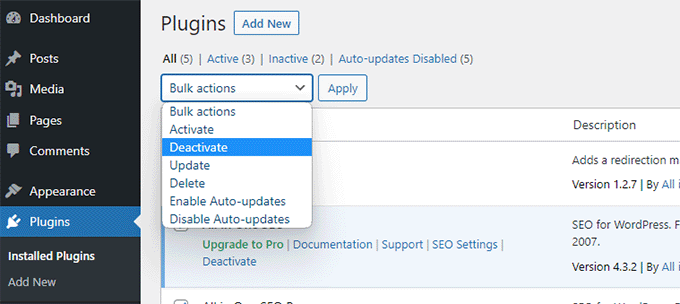
Tuttavia, se non riuscite ad accedere all’area di amministrazione di WordPress, potete disattivare tutti i plugin di WordPress utilizzando l’FTP.
È sufficiente collegarsi al proprio sito Web WordPress utilizzando un client FTP o l’applicazione di gestione dei file nel pannello di controllo del proprio account di hosting.
Una volta collegati, navigare nella cartella /wp-content/ e rinominare la cartella plugins in plugins.deactivated.
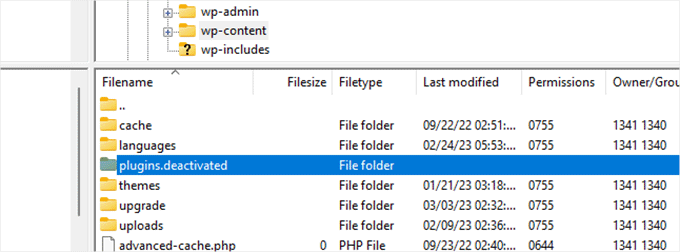
WordPress cerca i plugin nella cartella plugins. Se la cartella plugins non viene trovata, disattiverà automaticamente tutti i plugin.
Ora potete provare a visitare il vostro sito web per verificare se questo ha risolto l’errore del server interno sul vostro sito web.
Per ripristinare tutti i plugin, è sufficiente rinominare la cartella ‘plugins.deactivated’ in plugins.
I plugin verranno ripristinati, ma saranno ancora disattivati.
Ora è possibile attivare i singoli plugin e visitare il sito web per capire quale plugin sta causando l’errore interno del server.
Per maggiori dettagli, consultate la nostra guida su come disattivare tutti i plugin di WordPress senza wp-admin.
Se la disattivazione di tutti i plugin non ha risolto l’errore interno del server sul vostro sito web, continuate a leggere.
Passare a un tema WordPress predefinito
Una possibile causa dell’errore del server interno potrebbe essere un codice del tema di WordPress.
Per determinare se questo è il caso, è necessario cambiare il tema con un tema predefinito di WordPress.
Se avete accesso all’area di amministrazione di WordPress, andate alla pagina Aspetto ” Temi. Se è già installato un tema predefinito, è sufficiente fare clic sul pulsante Attiva per cambiare il tema.
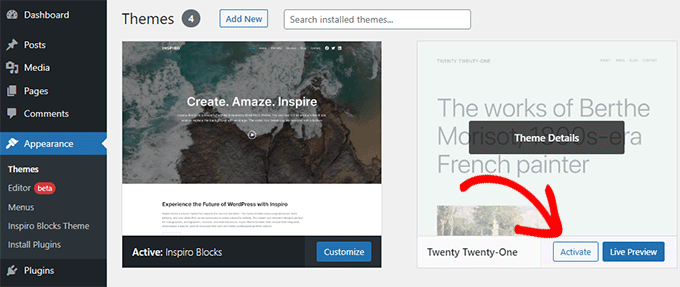
Se non avete installato un tema predefinito, potete fare clic sul pulsante “Aggiungi nuovo” in alto e installare un tema predefinito (Twenty Twenty-Three, Twenty Twenty-Two e così via).
Se non avete accesso all’area di amministrazione di WordPress, potete comunque passare a un tema predefinito.
È sufficiente collegarsi al proprio sito web WordPress utilizzando un client FTP e navigare nella cartella /wp-content/.
Fare clic con il pulsante destro del mouse per selezionare la cartella dei temi e scaricarla sul computer come backup.
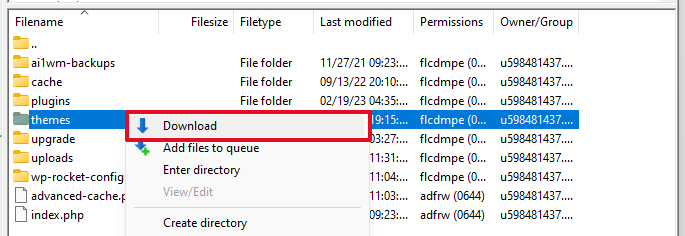
Successivamente, è necessario eliminare la cartella themes dal sito web. Una volta eliminata, creare una nuova cartella themes.
La nuova cartella dei temi sarà completamente vuota, il che significa che al momento non è stato installato alcun tema di WordPress.
Successivamente, è necessario visitare la directory dei temi di WordPress e scaricare un tema predefinito di WordPress sul computer.
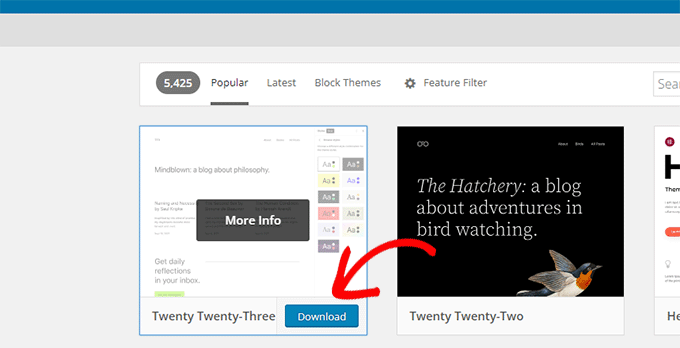
Il vostro browser scaricherà quindi il tema come file zip sul vostro computer.
Individuare il file sul computer e decomprimerlo. Gli utenti di Windows possono decomprimere il file facendo clic con il pulsante destro del mouse e selezionando “Estrai tutto”. Gli utenti Mac possono fare doppio clic sul file zip per estrarlo.
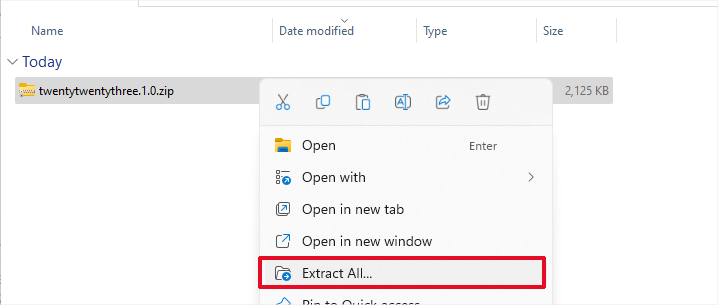
Ora vedrete una cartella contenente il vostro tema di WordPress.
Passare nuovamente al client FTP o al File Manager e caricare questa cartella nella cartella vuota dei temi.
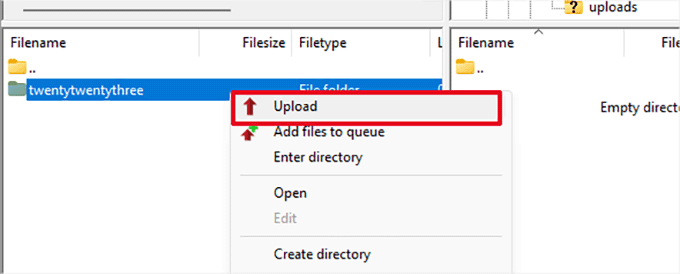
Una volta caricato, WordPress inizierà automaticamente a utilizzare il tema predefinito.
Ora è possibile visitare il sito web per verificare se l’errore del server interno è stato risolto.
Se non funziona, potete ricaricare i vostri temi WordPress dal backup o tornare al tema che stavate usando.
Non preoccupatevi. Ci sono ancora alcune cose che potete fare per risolvere l’errore.
Ricaricamento dei file del nucleo
Se le opzioni dei plugin e dei temi non hanno risolto l’errore interno del server, è opportuno ricaricare le cartelle /wp-admin/ e /wp-includes/ da una nuova installazione di WordPress.
Questa operazione NON rimuove le informazioni, ma può risolvere il problema nel caso in cui un file sia danneggiato.
Per prima cosa, è necessario visitare il sito web WordPress.org e fare clic sul pulsante “Download”.
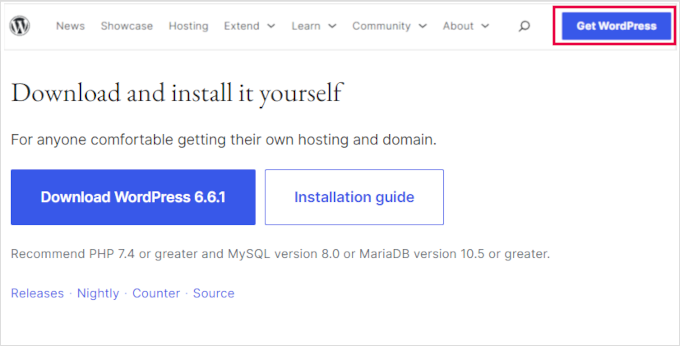
Questo scaricherà il file zip di WordPress sul vostro computer.
Procedere con l’estrazione del file zip. Al suo interno troverete una cartella wordpress.

Successivamente, è necessario collegarsi al proprio sito web WordPress utilizzando un client FTP.
Una volta collegati, accedere alla cartella principale del sito web. È la cartella che contiene le cartelle wp-admin, wp-includes e wp-content.
Nella colonna di sinistra, aprite la cartella WordPress sul vostro computer.
Ora è necessario selezionare tutti i file presenti nella cartella di wordpress e caricarli sul sito web.
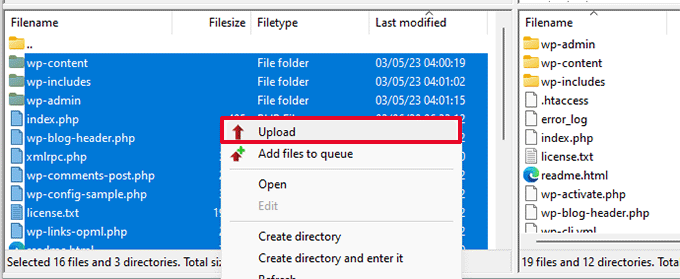
Il vostro client FTP trasferirà ora queste cartelle sul vostro server.
Verrà chiesto se si desidera sovrascrivere i file. Selezionare “Sovrascrivi”, quindi selezionare “Usa sempre questa azione” e selezionare la casella di controllo “Applica solo alla coda corrente”.
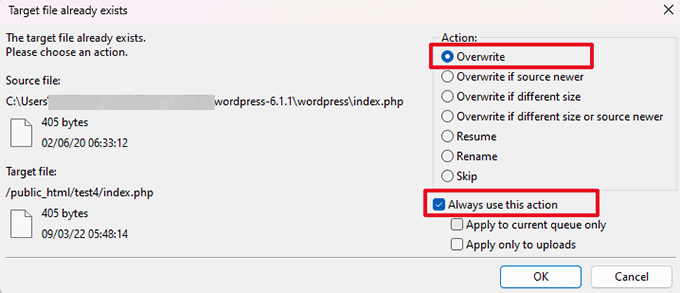
Il vostro client FTP sostituirà ora i vecchi file di WordPress con nuove copie fresche.
Se i file di WordPress sono stati danneggiati, questo passaggio risolverà l’errore interno del server.
Abilitare i log di debug in WordPress
WordPress è dotato di un sistema integrato per mantenere i log per il debug.
È possibile attivarlo utilizzando il plugin WP Debugging. Per maggiori dettagli, consultate la nostra guida su come installare un plugin di WordPress.
Una volta attivato, il plugin attiva i log di debug sul vostro sito web WordPress.
Se non avete accesso all’area di amministrazione del vostro sito WordPress, potete attivare il debug aggiungendo il seguente codice al file wp-config.php:
1 2 | define( 'WP_DEBUG', true);define( 'WP_DEBUG_LOG', true); |
Una volta attivati i log di debug, è possibile visualizzarli utilizzando un client FTP e navigando alla cartella /wp-content/.
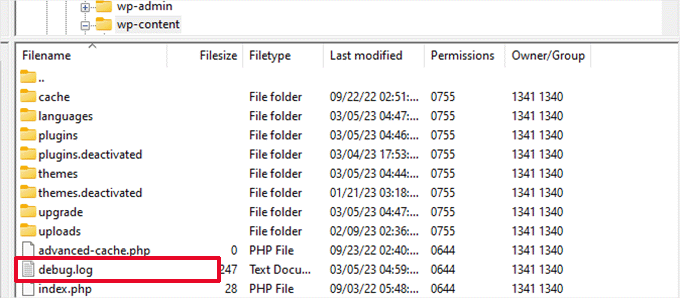
Il file di log di debug può essere aperto in un editor di testo e mostrerà un elenco di errori e avvisi che si verificano sul sito web.
Alcuni errori e avvisi possono essere incidenti innocui che non devono essere risolti. Tuttavia, se il vostro sito web presenta un errore interno del server, questi possono indicarvi la giusta direzione.
Chiedete al vostro fornitore di hosting
Se tutti i metodi non riescono a risolvere l’errore interno del server sul vostro sito web, allora è il momento di chiedere aiuto.
Contattare il team di assistenza del web hosting, che sarà in grado di controllare i registri del server e individuare la causa principale dell’errore.
Se volete continuare a risolvere i problemi da soli, consultate la nostra guida definitiva alla risoluzione dei problemi di WordPress per i principianti.
Video tutorial
Se questo articolo vi è piaciuto, iscrivetevi al nostro canale YouTube per le esercitazioni video su WordPress. Potete trovarci anche su Twitter e Facebook.





GEO D`ANJOS
It was necessary to update the plugin. Nothing more.
Very good this poster
Yasir
I encountered the following error :
Error 500 – Internal Server Error
An error was encountered while processing your request. Typically this is a temporary condition. Please contact the web site owner for further assistance.
So I talked to my hosting support and they suggest me the following procedure :
” Your cPanel account was set to use the PHP version 5.2, and it needed to be updated to the PHP 5.4 version. ”
Thanks ………. I worked for me ….
I am using inmotionhosting .
Venkateswarlu Santha
thanks so much… its working me
Sue
Thank you! Great advice even a non-techie volunteer can follow. The htaccess file was the main fix, but I could see by the logs that memory was creating a continual problem, so fixed that while I was at it.
Helpful Colin
I have not been in the situation where I have had to test my plugins by disabling them all yet, but if I had to test them all I would try this method to try and reduce the number of tests required after deactivating them all:
1. I would reactivate 50% of them. If the problem recurred I would know the problem plugin was in the reactivated group else it would be in the deactivated group.
2. If the problem was caused by the reactivated group I would deactivate 50% of them and retest else I would reactivate 50% of the other group that had not yet been reactivated and retest.
3. At this point I would know which group of 25% of all my plugins contained the faulty plugin and change the activation state of 50% of that group and retest.
4. At this point I would know which group of 12.5% of all my plugins contained the faulty plugin.
If I had 32 plugins the percentages above would divide them up very neatly into groups of 16, 8, 4, 2 and 1. It’s more likely that I would have to divide them into groups of unequal sizes but that doesn’t detract from the basic concept of reducing the number of tests to only 5 instead of 32.
If the problem proved to be with the only plugin I had not reactivated by this method then I would obviously carry out a sixth test with that plugin alone. If it proves that there is only a problem when it is activated along with other plugins then the scene would get complicated.
Warlley
That helped a lot! Thank you
mgarfath
it was w3 total cache plugin that caused error on my site, I renamed the cache folder but it didn’t changed any thing, then there were some other files that were written like w3 advanced cache.php something like that, I renamed EVERY FILE that had w3 cache or Even cache written on it worked but i accidentally deleted my .htaccess file, i had copied the content of the file safely, so i created new .htaccess file and uploaded it on the server, everything got fixed.
I hope this solution helps some one else who has this problem.
Than ks
Andrea S
thanks so much! I did, I was in panic, fortunately the first option (.htaccess) did the trick
anton
hello
i changed my theme to a tube video them named ” detube”
but after changing i am receiving a huge number of internal error 500 in Google webmaster( more then 800 error daily) and sometimes when i browsing my website don’t load and show me ” bandwidth limit resource” and also i receiving about 15 warning regarding to sitemap in Google webmaster
before changing theme i didn’t have any issues
can anyone help me? what can i do? i am losing my Google visitors
sarfraz khan
Thousand likes . .htaccess was problem and i just did it as shown in the video and the problem is solved
Gulshan Kumar
Internal Server Error mostly happens in Free Hosting. When I upgraded to premium, everything was on track.
Rich Finelli
This article has helped me at least twice in the last year! Thanks!
Joel Rodriguez
Deactivating Plugins solved my problem… Thanx a ton
Alberto Cardenas
Thanks mate, you saved my life hehehe, and gain a new follower, great site.
Serge
php.ini with memory=64Mb had solved my problem BIG THANKS!!!!
David
Very good
jakies
nop nothing of this soloutions solve the problem
toniak
many many thanks for this article
Nez
Thank you for these tips! It helped me a lot!
Imran Bughio
Bravo!
“Checking for Corrupt .htaccess File” This section helped me solve the issue, Thanks for the post
Sandile
Hi. Thank you for sharing this, I have recently experienced a 500 internal server error on my website but I re-uploaded wp-admin and wp-includes from fresh install, now everything is working in a good condition. Thank you.
Karan
The problem with my site is that sometimes it loads correctly and sometimes it shows 500 internal server error. Can you please tell me the reason for this?
Andrew P.
So, I have a really weird internal 500 error happening. My homepage loads up fine but whenever I click a link in the nav bar to go to another page the internal error pops up. I ran through this list of fixes and can’t seem to figure it out. Also my hosting provider doesn’t have a clue any ideas?
Sheff
Thank you for this. My dashboard crashed midway through a Wordfence Security update. I tried for over 3 hours to fix it but could not get into my dashboard. (500 http error in IE, white screen in firefox)
I was about to get my host to do a restore from last night and lose a day’s work until I found this page. I used FileZilla renamed the plugins folder on the serer to “plugins-frs” and was able to get into my dashboard with all 14 plugins deactivated. I then renamed the folder back to “plugins” and was able to activate them one at a time. They retained all of their settings, no problem.
I manually downloaded and uploaded the latest version of the Wordfence Security plugin that started my problems and activated the new version without issue.
I need to move to Newfoundland and become a cod fisherman before I go insane!
Sheff
Maher Aarag
What is a FTP?
And how to log in to my site using the FTP?
Do you mean log in to my Godaddy domain? or worldpress?
Prashant
FTP = File transfer protocol.
to login with ftp (in Godaddy Cpanel) you should go to your control panel and then go to FTP options and create new ftp by selecting ‘public_html’ directory and then login with any ftp clients like Filezilla.
host: ftp. yourdomain. com
username and password: as your specified while creating FTP user.
port: leave blank or 21.
Akpan Promise
FTP means file transfer protocol. It helps you transfer and edit files on your server.
FTP software for instance are Filezilla, CuteFTP.
Lisa Martin
Thanks you. I’ve used this technique multiple times on the same site. How can an .htcaccess file get corrupted? Is there anything that can be done to prevent it?
WPBeginner Support
You should check your .htaccess file permissions using an FTP client. These file permissions should be set to 644.
Admin
Lisa Martin
Thanks – I just thought to check here for your reply. The permission on the file is set to 644, but it keeps happening. It always works to rename the site and reload it, but often the client has to tell me his site is down before I know to go fix it for him. It looks like this is an issue in many WordPres forum threads as well.
Stephen Lee
Some plugins access the .htaccess and if there is a disruption to their function while doing so can introduce errors into the .htaccess coding.
Lisa Martin
Thank you. My solution for this recurring problem was to find all instances of “flush_rewrite_rules” and pass in “false,” so that the .htaccess file is not rewritten in the plugin code. https://codex.wordpress.org/Function_Reference/flush_rewrite_rules
I could not disable the plugin, since it is WooCommerce and that’s the whole basis for the site. This seems to be a pretty good fix for the situation I’m in.
Jon
Thank you for the tips, as I successfully recovered my site using these suggestions. A corrupt hta access file was the issue. Using FileZilla (highly recommended FTP Client) I was able to disable my plugin folder, then disable the hta access file.
Richard
What do I do when I can’t even enter the WP Admin without getting this error??
I can sign in fine and see those options, but the moment I want to enter the Admin panel, it gives me this error. I can’t even look up themes, customizer, etc because it involves the WP Admin menu.
What Do I Do?
Please Help
PS: I’ve never had issues with my site, but the WP Admin.
Hiago Ams
Great! Thanks so much, the best step by step available for most things I want is here
Danielle Olson
Thank you! This was so helpful. When I added _deactivate to my plugins folder, I got a different error message that had to do with one plugin in particular. So, I went in and added _deactivate to individual plugins until I found the one that was the problem.
msmith00
Just had an issue with this and thought I’d pass along my findings… looking in the root folder, a second .htaccess file had appeared overnight and created the 500 Internal error.
I simply removed the new .htaccess file (where it came from I don’t know), and all is back to normal.
Elliot K
This is the best WordPress help site around hands down! Love it so much! Guides are simple and everything always works for me first try. Thanks wpbeginner
Adil Adeel
This is a very informative and simple to understand tutorial for WP Beginners like me. I am using WordPress for last 5 years but as a blogger. Recently I had to install and look after couple of WordPress sites. Now 10 days back first WordPress site went down with 500 internal server error. I searched for the solution and landed on this page and did first step i-e renamed .htaccess file and problem was solved. Now again today the second site went down OMG !!!!! But again I visited this page to check for the solution.Now I have done all the steps explained on this page and nothing worked for me
OMG !!!!! But again I visited this page to check for the solution.Now I have done all the steps explained on this page and nothing worked for me  I have contacted the hosting provider and they are looking into problem for me. I will come back to share the solution once they rectify the problem. Thank you
I have contacted the hosting provider and they are looking into problem for me. I will come back to share the solution once they rectify the problem. Thank you
jofralogo
After trying everything (.htaccess, fresh install of wp-include/wp-admin, deactivate plugins…) I finally solve this problem doing this:
1) Create a new folder in your wp directory.
2) Move all files to this new directory.
3) Move them back to the original folder.
4) Ta-da!
I know it sounds stupid but it worked for me.
Shahin Shateri
This helped me a lot. fixed the issue.
JCP
Thanks for saving my ass guys, just got a new job and got thrown into fixing the website (despite not part of my job description) and wow, those pesky plugins! As deemyboy says: BACKUP that wp-content folder!!!!!!!
ed
maybe be a plugin
thankfulpj
Thank you so much for this guide! At least I was able to start somewhere while I wait for my hosting to check it. In my case, it was not any of the ones listed but a large error log on the home directory (it was 2GB) that did it. But when I re-uploaded the core files, I decided to delete it and it worked.
Paulo André Matta
Hi, I have tried all those sollutions above, but none worked for me. Im getting kind of desperated. Im new to WP.. I was changing some Settings (in the wp-admin link) and when I hit save, the 500 error came up. Idk what to do
Shaswat Shah
I uploaded the php.ini file to my /wp-admin/ folder. But now I am confused how can i know if 500 interneral server error is fixed or not ? because the error was coming simultaneously not all the time. Please help.
Patricia Mirasol
I know I got the internal service error because I was tinkering with my .htaccess file right before it occurred. Tried to log in using FTP clients (FileZilla and WinSCP) but I kept getting a connection error timeout. Just emailed my hosting provider. Hopefully, my provider will be able to help me with this.
Andrea Spila
Hi Silvia and thanks for this! I changed the permissions of the two files in wp-admin that were causing problems to 775 (from 664) and this solved then issue. And I don’t know why this happened too! It happened out of the blue. Mystery!
rajesh adulapuram
I tried all the above steps and finally when contacted My host provider iPage it was rectified. They told the problem is with file permissons and they rectified. This should have been my First step
Matt
I got back into my WP-Admin by renaming .htaccess but when I did settings>permalink>save as you recommend, I got locked out of admin again. Now renaming .htaccess does nothing. Any ideas?
Furkanicus
I’ve had this problem so many times and I feel comfortable sharing my advise on this as an 500 Error expert. Sometimes the problem was solved by changing the htaccess file, but it was a temporary solution. As it’s pointed out in the article, 500 service errror is mostly caused by PHP memory limit and unfortunately adding a php.ini file is not going to cut it. Most hosting companies set Php limit to 128MB, including Dreampress, and if you exceed that limit, your hosting provider will momentarily cut the connection to your website. My advise for you people who has this problem is this. Install P3 Plugin and designate the memory-hogging plugins. If they’re not essential, remove them. Also, changing your host provider to a boutique one instead of Bluehost or Hostgator will get your better customer service and higher product quality.
WPBeginner Staff
If you cannot find your .htaccess file, then you can always create a new blank file in a text editor. Name this file .htaccess and upload it to your website’s root directory using an FTP client.
Tobie! ®
i still have a problem with this. i cant find my .htaccess file, and i have been locked out of admin. the whole site can’t be viewed. please help me
Gaurav
.htaccess is hidden. When accessing your file make sure you can hidden file also
Michael Fuller
Use cPanel > File Manager to access files
Tobie! ®
i’ve tried all these, and it still doesnt work!! i cant find my .htaccess file and i cannot generate it because i’m locked out of admin, HELP PLEASE!!!
Chirag Patel
Change index.php permission to 644
Thomas
That did it for me after everything else didn’t work!
David Moore
Thank you, thank you. The index.php to 644 did the trick for me after all sorts of hassle.
Hasan Zaheer
Very helpful, but one more thing, mostly its due to w3 total cache plugin, if you have that you can rename cache plugin folder through FTP and then try, my site was fixed this way
jim
thx … clear w3 cache solve my problem